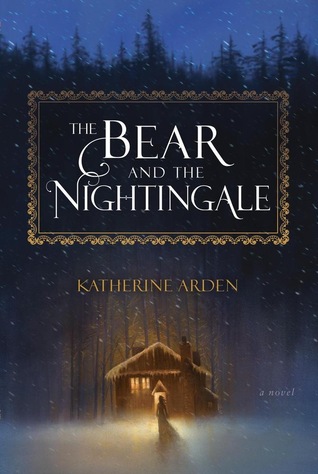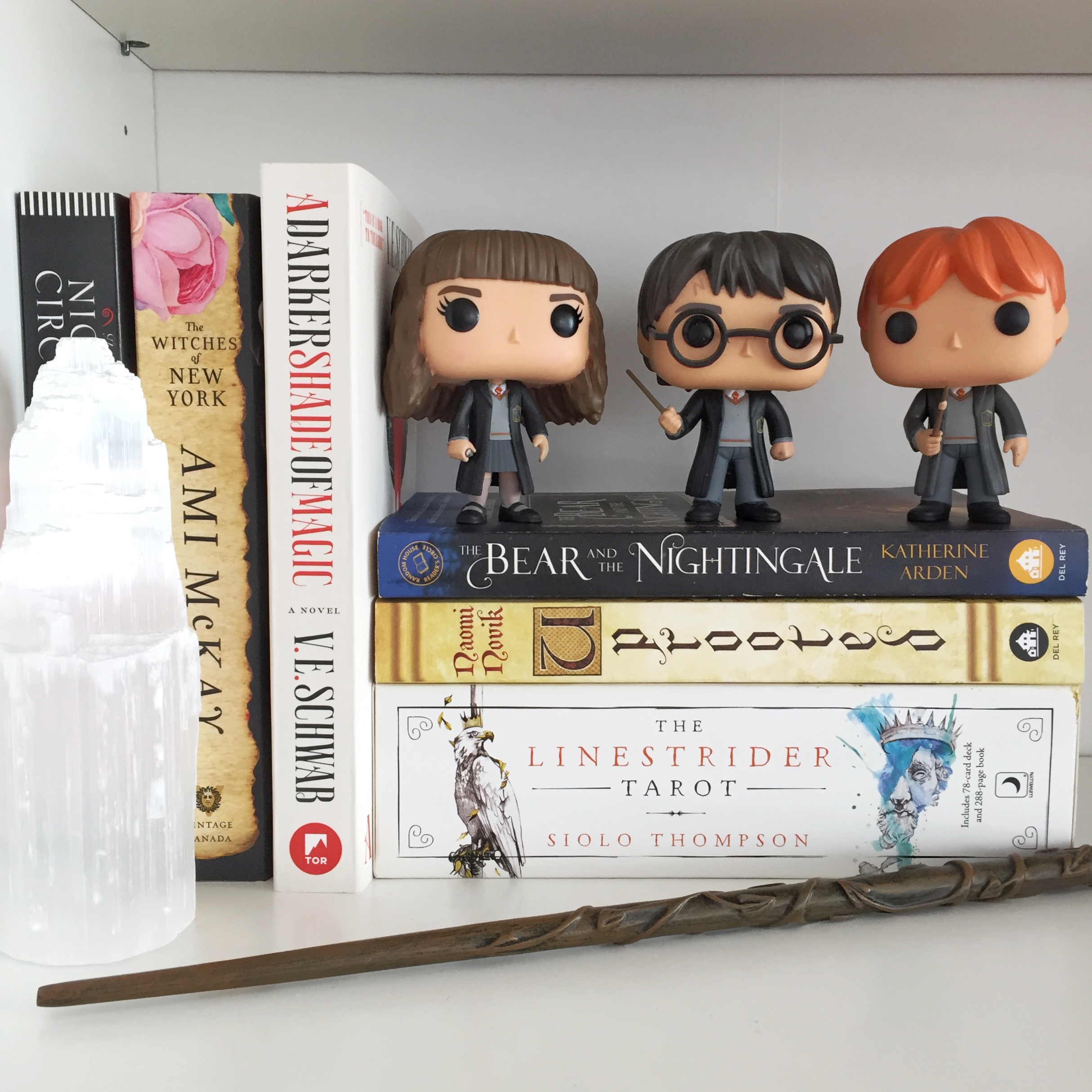
Take a break from reality by delving into these unique, magical, out-of-this-world reads.
Reading fantasy novels is often seen as a way to escape real life—and that’s definitely a big draw. There’s always some current event happening that makes us want to stick our heads in the sand and ignore it all. But sometimes fantasy can be used as a way to explore real issues, just using a different, carefully-controlled lens. I tend to read a lot of fantasy written by women, because I find that female fantasy authors use their writers’ magic to create worlds where female characters are given all the agency they wouldn’t have in, say, a realistic historical novel. So naturally, when I put together our Fantastic Worlds reading list, the ones I was personally drawn to all made me analyze their different representations of female characters.
The first book I read was The Bear and the Nightingale by Katherine Arden, which perhaps isn’t the most obvious choice for a summer read, unless you’re looking for an antidote to the summer heat. Set deep in the near-wilderness of Northern Russia, winter is a Game of Thrones-esque threat. “The Wood” isn’t an idyllic retreat, it’s a danger. This is a story written by someone who has experienced a northern winter first-hand; descriptions of winter are woven throughout the novel, creating a sense of relentless cold that I felt even as I sat reading in the sunshine. The sense of place is really what stood out to me about the novel, which I found short on plot but high in atmosphere. Arden also makes excellent use of the “wild girl” trope—the one who is destined to a life of domesticity but belongs in the woods.
 But weirdly, the character that struck me the most is Vasya’s reluctant stepmother Anna. We all know the Wicked Stepmother figure: she’s usually cold, cruel, and jealous, almost exclusively towards our poor protagonist. Basically, she’s one of the most misogynistic figures in folklore. Why is she so evil? Because a younger girl is more beautiful than her? What Arden does with Anna is give her a reason to be so malicious. Anna sees demons. People call her crazy, and she’s unattractive to boot—a double whammy in the unmarriageable department. Her one goal in life is to land herself in a convent, where she will forever be protected from the pagan Russian creatures. So of course, she’s forced into a marriage and shipped off to live in the wilds of Russia, where the demons run rampant. I sympathized with her quite a bit, although I have to say I expected Arden to take this subversion further. As the novel goes on, Anna falls further into the Wicked Stepmother role without much redemption, becoming as stock a character as the Claude Frollo-like priest Konstantin. But regardless, I really liked this approach to the traditional fairy tale roles.
But weirdly, the character that struck me the most is Vasya’s reluctant stepmother Anna. We all know the Wicked Stepmother figure: she’s usually cold, cruel, and jealous, almost exclusively towards our poor protagonist. Basically, she’s one of the most misogynistic figures in folklore. Why is she so evil? Because a younger girl is more beautiful than her? What Arden does with Anna is give her a reason to be so malicious. Anna sees demons. People call her crazy, and she’s unattractive to boot—a double whammy in the unmarriageable department. Her one goal in life is to land herself in a convent, where she will forever be protected from the pagan Russian creatures. So of course, she’s forced into a marriage and shipped off to live in the wilds of Russia, where the demons run rampant. I sympathized with her quite a bit, although I have to say I expected Arden to take this subversion further. As the novel goes on, Anna falls further into the Wicked Stepmother role without much redemption, becoming as stock a character as the Claude Frollo-like priest Konstantin. But regardless, I really liked this approach to the traditional fairy tale roles.
Uprooted by Naomi Novik is another fairy-tale inspired novel, although this one is a stand-alone (highly unusual for the fantasy genre!). Again, this is a writer who clearly knows her subject inside and out; Uprooted takes its inspiration from Polish folklore, which served as bedtime stories told by Novik’s Polish mother. The ominous Wood is back, but this time it’s even more threatening: encroaching on bordering villages, the Wood snatches people up. There’s a typical dynamic between our main character Agnieszka and the Dragon (not actually a dragon, but a wizard with that name) where she’s an endearing klutz and he’s a standoffish jerk, which smacks too much of fanfiction for my taste. What stopped me from rolling my eyes too hard is Agnieszka’s friendship with the beautiful Kasia, which does actually subvert the jealous female trope. Rather than seeing Kasia as competition—she is, after all, beautiful, talented, and feminine—Agnieszka views her as a sister, and their bond is what drives the plot. This is the kind of female relationship I love seeing in media.
 But my favourite book on this list has to be The Witches of New York, by Canadian author Ami McKay. This is mostly for personal reasons: I’ve always wanted my life to be a version of Practical Magic, so anything resembling that scores points in my book. Witches of New York focuses on a trio of witchy businesswomen in 1880s New York—not an easy time to be a witch, or a businesswoman. McKay presents the shop Tea & Sympathy as a place of refuge for women in a time of oppressive patriarchy. Just like The Bear and the Nightingale, there is a malevolent religious figure, and the story is populated with the spirits of people lost to the hysterical paranoia of witch hunts. McKay’s own history contributes to the foundation of the novel, as one of her ancestors was tried and hanged as a witch in Salem. The Witches of New York has supernatural elements, but McKay uses historical facts to shape an image of a woman’s daily life in the 1880s. There’s a part where an institutionalized woman lists all the reasons her fellow inmates have been sent to an asylum, and it’s both hilarious and unbelievable (you can actually find a similar list online). But despite all this, the women in the story create a support system for each other, even when they don’t always get along.
But my favourite book on this list has to be The Witches of New York, by Canadian author Ami McKay. This is mostly for personal reasons: I’ve always wanted my life to be a version of Practical Magic, so anything resembling that scores points in my book. Witches of New York focuses on a trio of witchy businesswomen in 1880s New York—not an easy time to be a witch, or a businesswoman. McKay presents the shop Tea & Sympathy as a place of refuge for women in a time of oppressive patriarchy. Just like The Bear and the Nightingale, there is a malevolent religious figure, and the story is populated with the spirits of people lost to the hysterical paranoia of witch hunts. McKay’s own history contributes to the foundation of the novel, as one of her ancestors was tried and hanged as a witch in Salem. The Witches of New York has supernatural elements, but McKay uses historical facts to shape an image of a woman’s daily life in the 1880s. There’s a part where an institutionalized woman lists all the reasons her fellow inmates have been sent to an asylum, and it’s both hilarious and unbelievable (you can actually find a similar list online). But despite all this, the women in the story create a support system for each other, even when they don’t always get along.
What kind of fantasy story do you enjoy? Do you like them to address social issues, or do you prefer to escape reality completely? Have you ever wanted to live in a specific fantastic world? Let us know in the comments!

The Bear and the Nightingale looks really interesting! I really enjoyed Boy, Snow, Bird by Helen Oyeyemi, which also uses a lot of fairytale structure and tropes such as the good dead mother, the evil stepmother, and Prince Charming, but subverts all of those roles and infuses them with much more life and complexity than a fairytale could ever give. I quite like it when authors toy around with something that’s so entrenched – in this case, fairytales – and play with our expectations of it. That’s regardless of whether they are commenting on a social issue or not, so I suppose a complete escape from reality is what I go for, though I personally don’t get any more of an escape from reality when I’m reading fantasy as compared to when I’m reading any other genre of fiction.
Thank you for this list! I’ve read a few of them. I haven’t yet read “The Bear and the Nightingale” – it sounds really interesting. I’m currently in the middle of “The Invisible Library” by Genevieve Cogman, and am really enjoying it so far (I read almost half of it last night!).
I also had mixed feelings about “Uprooted” by Naomi Novik. Like you, I enjoyed the friendship between Agnieszka and Kasia, and found the idea of the Wood fascinating. However, I was often annoyed by the interactions between Agnieszka and the Dragon.
When I read fiction, I tend to choose fantasy – I enjoy the escape, world-building, magic, etc. I used to read and reread a lot of fantasy series when I was much younger, and some of them hold up better than others – of course, with age, your perspectives change based on your experiences, and you may notice things you didn’t notice when you’ve read them as a child/teen/young adult.